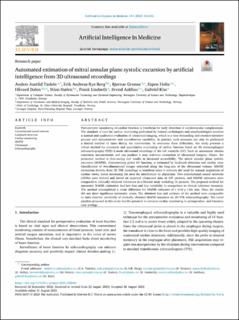Automated estimation of mitral annular plane systolic excursion by artificial intelligence from 3D ultrasound recordings
Tasken, Anders Austlid; Berg, Erik Andreas Rye; Grenne, Bjørnar Leangen; Holte, Espen; Dalen, Håvard; Stølen, Stian Bergseng; Lindseth, Frank; Aakhus, Svend; Kiss, Gabriel Hanssen
Peer reviewed, Journal article
Published version
Permanent lenke
https://hdl.handle.net/11250/3111142Utgivelsesdato
2023Metadata
Vis full innførselSamlinger
Originalversjon
10.1016/j.artmed.2023.102646Sammendrag
Perioperative monitoring of cardiac function is beneficial for early detection of cardiovascular complications. The standard of care for cardiac monitoring performed by trained cardiologists and anesthesiologists involves a manual and qualitative evaluation of ultrasound imaging, which is a time-demanding and resource-intensive process with intraobserver- and interobserver variability. In practice, such measures can only be performed a limited number of times during the intervention. To overcome these difficulties, this study presents a robust method for automatic and quantitative monitoring of cardiac function based on 3D transesophageal echocardiography (TEE) B-mode ultrasound recordings of the left ventricle (LV). Such an assessment obtains consistent measurements and can produce a near real-time evaluation of ultrasound imagery. Hence, the presented method is time-saving and results in increased accessibility. The mitral annular plane systolic excursion (MAPSE), characterizing global LV function, is estimated by landmark detection and cardiac view classification of two-dimensional images extracted along the long-axis of the ultrasound volume. MAPSE estimation directly from 3D TEE recordings is beneficial since it removes the need for manual acquisition of cardiac views, hence decreasing the need for interference by physicians. Two convolutional neural networks (CNNs) were trained and tested on acquired ultrasound data of 107 patients, and MAPSE estimates were compared to clinically obtained references in a blinded study including 31 patients. The proposed method for automatic MAPSE estimation had low bias and low variability in comparison to clinical reference measures. The method accomplished a mean difference for MAPSE estimates of (-0.16 +- 1.06) mm. Thus, the results did not show significant systematic errors. The obtained bias and variance of the method were comparable to inter-observer variability of clinically obtained MAPSE measures on 2D TTE echocardiography. The novel pipeline proposed in this study has the potential to enhance cardiac monitoring in perioperative- and intensive care settings. Automated estimation of mitral annular plane systolic excursion by artificial intelligence from 3D ultrasound recordings
Utgiver
ElsevierTidsskrift
Artificial Intelligence in MedicineBeslektede innførsler
Viser innførsler beslektet ved tittel, forfatter og emneord.
-
Guest Editorial Artificial Intelligence and Deep Learning for Intelligent and Sustainable Traffic and Vehicle Management (VANETs)
Gupta, Brij B.; Agrawal, Dharma P.; Sajjad, Muhammad; Sheng, Michael; Del Ser, Javier (Peer reviewed; Journal article, 2022)Intelligence and sustainability are two essential drivers for the development of current and future Intelligent Transportation Systems. On one hand, the complexity of vehicular ecosystems and the inherently risk-prone ... -
State-of-the-Art on Artificial Intelligence for Risk-based Decision-making in Autonomous Marine Vehicles
Maidana, Renan Guedes; Utne, Ingrid Bouwer; Sørensen, Asgeir Johan (Chapter, 2020)Risk assessment (i.e., risk analysis and risk evaluation) is routinely performed in marine operations by vessel crews to inform and support the decision-making process for the ship’s operations. With the inevitable ubiquity ... -
Real-time optimized drilling operation by using Artificial Intelligence
Shokouhi, Samad Valipour (Doktoravhandlinger ved NTNU, 1503-8181; 2013:27, Doctoral thesis, 2013)

